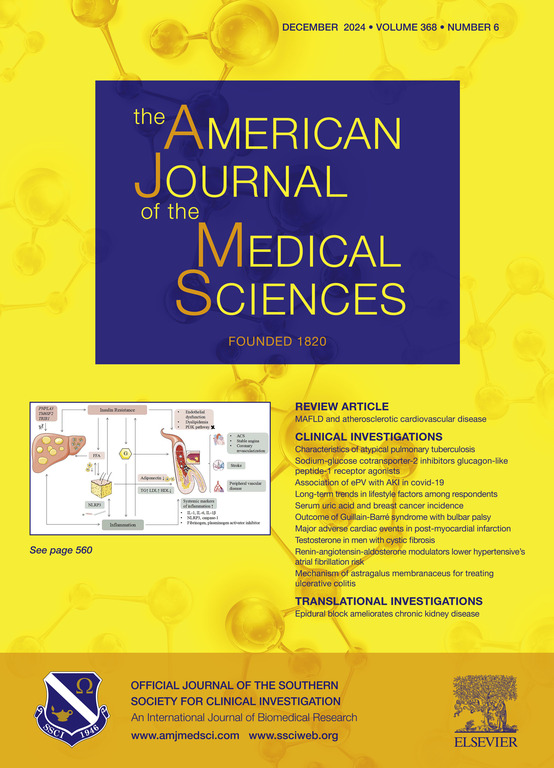红斑癌,病例报告和文献中 69 个病例的回顾。
IF 1.8
4区 医学
Q2 MEDICINE, GENERAL & INTERNAL
引用次数: 0
摘要
背景:红斑癌(CE)是一种罕见的皮肤转移瘤,表现与红斑或蜂窝组织炎相似。由于其罕见性,人们对其知之甚少:方法:我们在此初步报告了一例继发于直肠癌的 CE 病例,然后回顾了文献并分析了之前报告的病例的基本特征:结果:共发现 69 例 CE 患者(包括我们的病例)。平均确诊年龄为 60±15 岁(最小 25 岁,最大 91 岁),69.6% 的患者为女性。乳腺癌、皮肤癌和胃食管癌是最常见的三种恶性肿瘤(分别占 52.2%、11.6% 和 10.1%)。腺癌(81.2%)是病例的主要组织学亚型。20.3%的患者首次发病时为CE,69.7%的患者复发或病情恶化时为CE。从首次发病到确诊 CE 的中位时间为两年。半数以上的患者(55.1%)在确诊 CE 之前曾接受过其他鉴别诊断的局部皮肤病治疗。只有 21.7% 的患者对治疗有反应,确诊 CE 后的中位生存期为 4 个月(最短:0 个月,最长:24 个月):结论:CE预后较差,最常见于乳腺癌和腺癌患者。患者通常会接受不同诊断的局部皮肤病治疗。在鉴别诊断中应考虑 CE,尤其是在有恶性肿瘤病史或对局部治疗无效的患者出现红斑/蜂窝织炎样皮损时。本文章由计算机程序翻译,如有差异,请以英文原文为准。
Carcinoma erysipeloides, a case-report and review of the sixty-nine cases in the literature
Background
Carcinoma erysipeloides (CE) is a rare form of cutaneous metastasis appearing similar to erysipelas or cellulitis. Due to its rarity, little is known about CE.
Methods
We here initially reported a case of CE secondary to rectal carcinoma and then reviewed the literature and analyzed the basic characteristics of the cases reported previously.
Results
Sixty-nine patients(including our case) with CE were identified. The mean age of diagnosis with CE was 60 ± 15 yr(min:25 yr, max:91 yr), and 69.6 % of the patients were female. Breast cancer, skin cancer, and gastroesophageal cancer were the three most commonly seen malignancies presented with CE(52.2 %, 11.6 %, and 10.1 %, respectively). Adenocarcinoma(81.2 %) was the primary histological subtype of the cases. While CE was the first presentation of the disease in 20.3 % of patients, it was associated with recurrence or disease progression in 69.7 %. The median time from the first presentation of the disease to the diagnosis of CE was two years. More than half of the patients(55.1 %) have received local dermatological treatment with another differential diagnosis before diagnosis of CE. Only 21.7 % of the patients responded to the treatment, and median survival after diagnosis of CE was 4 months(min:0 mo, max:24 mo).
Conclusions
CE has a poor prognosis and is most common in individuals with breast cancer and adenocarcinoma. Patients generally receive local dermatological treatments with different diagnoses. CE should be considered in the differential diagnosis, especially in the presence of erysipelas/cellulitis-like lesions in patients with a history of malignancy or who do not respond to local treatments.
求助全文
通过发布文献求助,成功后即可免费获取论文全文。
去求助
来源期刊
CiteScore
4.40
自引率
0.00%
发文量
303
审稿时长
1.5 months
期刊介绍:
The American Journal of The Medical Sciences (AJMS), founded in 1820, is the 2nd oldest medical journal in the United States. The AJMS is the official journal of the Southern Society for Clinical Investigation (SSCI). The SSCI is dedicated to the advancement of medical research and the exchange of knowledge, information and ideas. Its members are committed to mentoring future generations of medical investigators and promoting careers in academic medicine. The AJMS publishes, on a monthly basis, peer-reviewed articles in the field of internal medicine and its subspecialties, which include:
Original clinical and basic science investigations
Review articles
Online Images in the Medical Sciences
Special Features Include:
Patient-Centered Focused Reviews
History of Medicine
The Science of Medical Education.

 求助内容:
求助内容: 应助结果提醒方式:
应助结果提醒方式:


